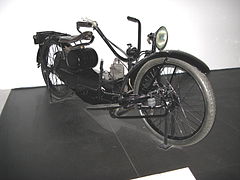Ner-a Car
 |
|
| Manufacturer | Ner-A-Car Corporation (United States) Sheffield-Simplex (United Kingdom) |
|---|---|
| Also called | Neracar |
| Production | 1921–1927 |
| Assembly |
Syracuse, New York, USA Kingston-on-Thames, UK |
| Class | Feet Forward |
| Top speed | 35 mph |
| Power | 2.5 hp |
| Transmission | 5-position friction drive CVT, 3-speed manual |
| Frame type | Pressed steel perimeter frame |
| Suspension | Front: Double leading arms with hub-center steering Rear: none, except for 1926 de-luxe model with swingarm and quarter-elliptic leaf springs |
| Brakes | Drum, operated by pedal located on left foot board. |
| Tires | 26 x 3-inch non-skid |
| Wheelbase | 59 in (1,500 mm) (standard) 68.5 in (1,740 mm) (with rear suspension) |
| Dimensions |
L: 84 in (2,100 mm) |
| Weight | 175 pounds (dry) |
| Turning radius | 19 ft 6 in (5,940 mm) turning circle |
The Ner-A-Car was a type of feet forwards motorcycle designed by Carl Neracher in 1918. About 10,000 of these motorcycles were manufactured in the United States by the Ner-A-Car Corporation under the Neracar name, while around 6,500 are believed to have been produced in England under licence in England by the Sheffield-Simplex company between 1921 and 1926 under the Ner-A-Car name.
The design had several unusual features, including a friction drive transmission, and a low-slung perimeter frame chassis that was closer to those found on contemporary cars than other motorcycles. It also featured the first production example of hub-center steering on a motorcycle. The low-slung frame, front suspension, hub-center steering, and long wheelbase contributed to the cycle's exceptional stability.
While similar in concept to a continuously variable transmission, the friction drive transmission has five fixed indents corresponding to pre-set drive ratios.
Neracher licensed his design to Sheffield-Simplex to manufacture Ner-A-Cars for the British and Commonwealth markets before he could find any investors to manufacture them in the United States. Eventually, a group of investors, including King C. Gillette and Crouse-Hinds Company founder Huntington B. Crouse, funded the Ner-A-Car Corporation, which began production of Neracars in October 1921.
The Ner-A-Car was marketed as a low cost alternative to a motor car. The advertizers publicized the Ner-A-Car's step-through design and its protection from road grime and engine fluids, both of which allowed riders to wear ordinary clothes, including skirts, cassocks, and kilts, while riding the cycle.
Erwin G. "Cannonball" Baker rode a Neracar from Staten Island, New York, to Los Angeles, California, in the autumn of 1922. The journey of 3,364.4 miles took 174 hours and one minute to complete, with operating costs totalling $15.70 at the time. Baker later started a Neracar dealership in Los Angeles.
The Ner-A-Car won several medals for reliability in long-distance road trials, including the team prize in the 1925 ACU 1000 mile Stock Machine Trial.
...
Wikipedia
